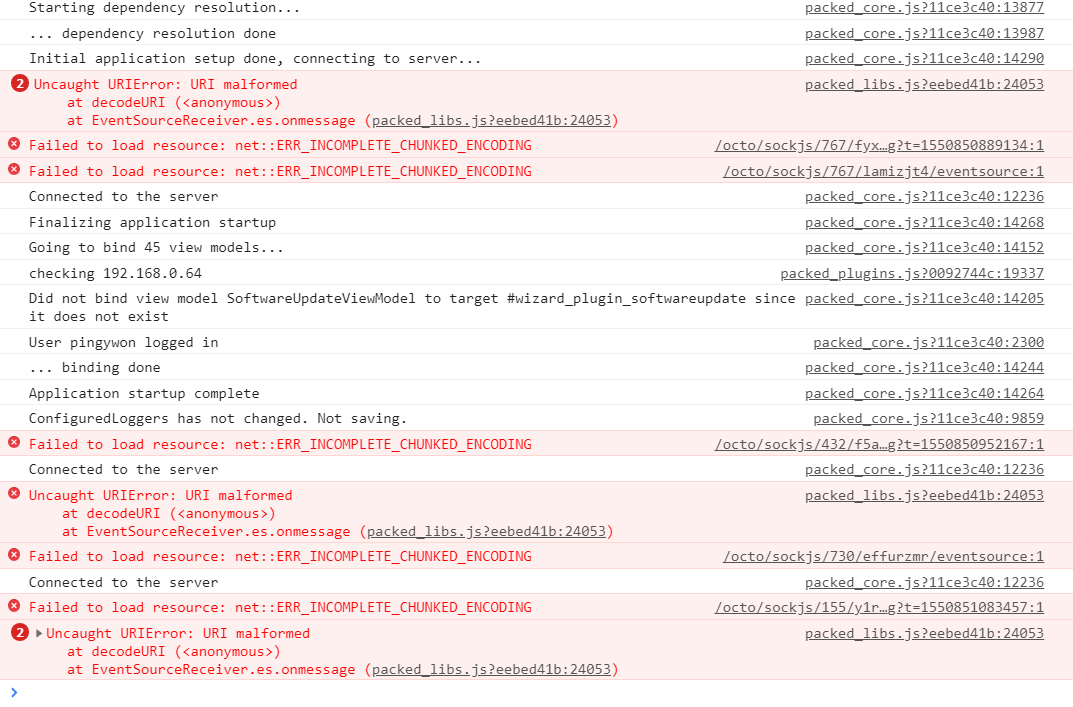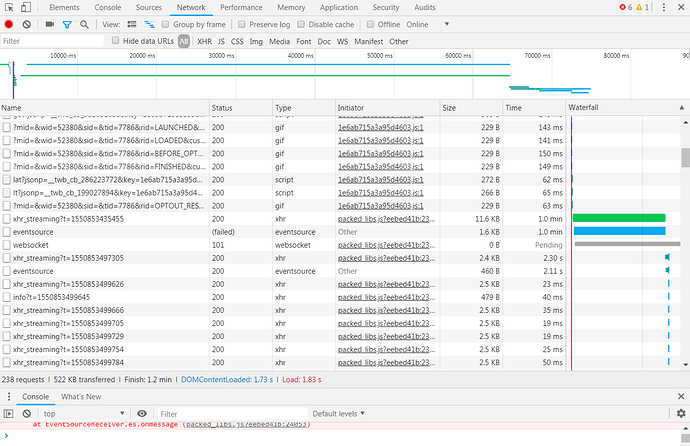Next step will be a deep dive into the JS error console and the Network tab I fear. Something's hanging. Oh, also - same issue in safe mode?
Looks like it isn't connecting via the websocket and falling back on a long poll transport, and running into timeout issues with that.
The question is why it's not connecting via proper websocket in the first place, the Network tab might have the answer to that.
Hm, nope, the problem is higher up. Or at least I'd expect it to be higher up. The first thing that happens on socket initialization is a request to sockjs/info (IIRC), then a websocket will be attempted to be opened, then if that fails it's a fallback to various long polling approaches. Here I see an open websocket  and a failed attempt to use the
and a failed attempt to use the eventsource backend.
Frankly, this confuses me 
well - good. because I am confused by it also.
This being a current sandbox env I am throwing the kitchen sink at it.
I took the stack-overflow advice and changed the owner of the /var/lib/nginx to the nginx user who is running the worker process.
The /var/cache/nginx dir was already owned by the nginx user.
I also changed the:
proxy_buffers 8 1024k; proxy_buffer_size 1024k;
all to no current avail. I have not totally broken nginx though - so I guess that is a good thing.
I have read some stack over flow threads and searched around to no avail - these seem to be the errors that are making it hang
Hi,
I have another probem  I have two printer with octoprint.
I have two printer with octoprint.
Now I would like to have nginx as reverse proxy with basic authentification.
This works fine with the first instance, with /printer1 and /webcam. And here is the trouble. I can setup /printer2 to show the second octoprint, but I can't add a second location for the webcam on the second octoprint.
Is there a way to change the /webcam stream to another location?
Cheers
Kiwix
Thanks for the example. This is just want I was looking for to get started with an niginx reverse proxy for OctoPrint!
I'm using Nginx in a docker container with built in letsencrypt support and SSL, but the principle should be the same. Here's what I've got to serve up Octoprint on a subfolder of my main domain and with a webcam (Logitech C920) working fine.
My Raspberry Pi has a static IP on 192.168.0.240.
I can reach Octoprint on https://server.com/octoprint & the webcam on https://server.com/octocam
This reverse proxy configuration works "out the box" with no edits required to /boot/octoprint.txt
location /octoprint/ {
proxy_pass http://192.168.0.240/;
proxy_set_header Host $http_host;
proxy_set_header Upgrade $http_upgrade;
proxy_set_header Connection "upgrade";
proxy_set_header X-Real-IP $remote_addr;
proxy_set_header X-Forwarded-For $proxy_add_x_forwarded_for;
proxy_set_header X-Scheme $scheme;
proxy_set_header X-Script-Name /octoprint;
proxy_http_version 1.1;
client_max_body_size 0;
}
location /octocam/ {
proxy_pass http://192.168.0.240:8080/;
proxy_set_header Host $http_host;
proxy_set_header Upgrade $http_upgrade;
proxy_set_header Connection "upgrade";
proxy_set_header X-Real-IP $remote_addr;
proxy_set_header X-Forwarded-For $proxy_add_x_forwarded_for;
proxy_set_header X-Scheme $scheme;
proxy_set_header X-Script-Name /octocam;
proxy_http_version 1.1;
client_max_body_size 0;
}
Once you've confirmed that the above two are working you can configure Octoprint in the webui with a webcam stream URL of https://server.com/octocam/?action=stream and a snapshot URL of https://server.com/octocam/?action=snapshot
Obviously the IP of 192.168.0.240 and server.com will be replaced by whatever you are using in your setup.
Just posting here in case anybody is struggling.
Any chance you can share your subdomain config info? I'm using letsencrypt in a docker image on an R710 server and trying to figure out the proper subdomain config file
Thanks for posting that!
I Copy pasted that into a file "octoprint.subfolder.conf" in the config files for my LinuxServer/LetsEncrypt container, and it worked perfectly.
I was previously working fine using subdomains, but I needed to change my certificate so I restructured LetsEncrypt.
Here was the working config I had for a LetsEncrypt Subdomain:
@jagr200
# make sure that your dns has a cname set for deluge and that your deluge container is not using a base url
server {
listen 443 ssl;
listen [::]:443 ssl;
server_name octoprint.*;
include /config/nginx/ssl.conf;
client_max_body_size 0;
# enable for ldap auth, fill in ldap details in ldap.conf
#include /config/nginx/ldap.conf;
location / {
# enable the next two lines for http auth
#auth_basic "Restricted";
#auth_basic_user_file /config/nginx/.htpasswd;
# enable the next two lines for ldap auth
#auth_request /auth;
#error_page 401 =200 /login;
# DO NOT INCLUDE THE DEFAULT - OVERRIDES BELOW
#include /config/nginx/proxy.conf;
#Settings per this link: https://community.octoprint.org/t/reverse-proxy-configuration-examples/1107
proxy_set_header Host $http_host;
proxy_set_header Upgrade $http_upgrade;
proxy_set_header Connection "upgrade";
proxy_set_header X-Real-IP $remote_addr;
proxy_set_header X-Forwarded-For $proxy_add_x_forwarded_for;
proxy_set_header X-Scheme $scheme;
proxy_http_version 1.1;
client_max_body_size 0;
#Settings from the proxy.conf that need to be imported since import was disabled
client_body_buffer_size 128k;
#Timeout if the real server is dead
proxy_next_upstream error timeout invalid_header http_500 http_502 http_503;
# Advanced Proxy Config
send_timeout 5m;
proxy_read_timeout 240;
proxy_send_timeout 240;
proxy_connect_timeout 240;
# TLS 1.3 early data
proxy_set_header Early-Data $ssl_early_data;
# Basic Proxy Config
proxy_set_header X-Forwarded-Proto https;
proxy_set_header X-Forwarded-Host $host;
proxy_set_header X-Forwarded-Ssl on;
proxy_redirect http:// $scheme://;
proxy_cache_bypass $cookie_session;
proxy_no_cache $cookie_session;
proxy_buffers 32 4k;
proxy_headers_hash_bucket_size 128;
proxy_headers_hash_max_size 1024;
#Required in this file
resolver 127.0.0.11 valid=30s;
set $upstream_octoprint 192.168.1.105;
proxy_pass http://$upstream_octoprint;
}
}
I have a different issue. Created a separate topic Nginx reverse proxy stuck at "Loading OctoPrint's UI, please wait..."
I stumpled across this, coming from Unable to display OctoPrint inside Home Assistant iframe
haproxy example from first post is deprecated, for reference my current version:
backend octoprint
# ref https://community.octoprint.org/t/reverse-proxy-configuration-examples/
http-request replace-path ^([^\ :]*)\ /local_octoprint_proxy/(.*) \1\ /\2
http-request add-header X-Script-Name %[req.hdr(X-Ingress-Path)]
option forwardfor
server octoprint OCTOPRINT_HOST:OCTOPRINT_PORT USE_SSL VERIFY_SSL check
The http-request add-header X-Script-Name is the most important.
I run some small haproxy against the octopi image which also runs some haproxy. Because, why not.
Here is a basic Caddy Server v2 configuration, assuming you are running Caddy on the same machine as the OctoPrint. It is easy to adapt if your OctoPrint installation is on another machine. The example is in the "Caddyfile" style.
localhost
reverse_proxy 127.0.0.1
header_up X-Scheme {scheme}
That's it.
In my specific case, I have a subdomain assigned to the OctoPrint installation, which is running on another machine from Caddy Server. My configuration is thus:
subdomain.example.com {
reverse_proxy 192.168.0.100 {
header_up X-Scheme {scheme}
}
}
Because I have not specified http at the beginning of subdomain.example.com, the default is assumed to be https, and it will automatically generate a Let's Encrypt certificate and attach it by default.
I was looking for a Caddy example to replace the haproxy.cfg (to use Caddy instead of HAProxy). It's surprisingly simple:
host.domain:80 {
reverse_proxy localhost:5000
handle_path /webcam* {
reverse_proxy localhost:8080
}
}
47 lines of haproxy.cfg are replaced with 6 lines of Caddyfile. And if you want TLS, it's just a few lines more (if this were exposed to the Internet, which it shouldn't be, you'd get TLS by just getting rid of :80 on the first line--but if it's internal, you'd need to configure for DNS validation, or use Caddy's internal CA).
I have added octoprint to my existing nginx reverse proxy.
I generally followed the first post and it was successful.
However, in the octoprint settings, I had to add a period to the beginning of the Stream URL in the webcam.
As follows.
./webcam/?action=stream
PSA: haproxy 2.2.x (included in Debian 11 "Bullseye") no longer supports the reqrep configuration keyword. Instead, it uses http-request replace-path. The above haproxy.cfg needs to have the
reqrep ^([^\ :]*)\ /webcam/(.*) \1\ /\2
line in the backend webcam section replaced with
http-request replace-path /webcam/(.*) /\1
If you're upgrading a 0.18 or earlier version of OctoPi to Bullseye (or just upgrading haproxy to 2.2.x) then as well as the change above you also need to remove the reqrep line in the backend octoprint section in the default OctoPi configuration file. There is no need to add a new http-request line in the backend octoprint section to replace it.
Thank you @MMcLure, you got me pointed in the right direction. After updating the OctoPi 0.18.0 image from Buster to Bullseye I had to correct my HAProxy.cfg to the below setup. Only required me to make changes to anything related to reqrep or reqadd.
global
maxconn 4096
user haproxy
group haproxy
daemon
log 127.0.0.1 local0 debug
tune.ssl.default-dh-param 2048
defaults
log global
mode http
compression algo gzip
option httplog
option dontlognull
retries 3
option redispatch
option http-server-close
option forwardfor
maxconn 2000
timeout connect 5s
timeout client 15min
timeout server 15min
frontend public
bind *:80 v4v6
bind *:443 v4v6 ssl crt /etc/ssl/snakeoil.pem
option forwardfor except 127.0.0.1
use_backend webcam if { path_beg /webcam/ }
use_backend webcam_hls if { path_beg /hls/ }
use_backend webcam_hls if { path_beg /jpeg/ }
default_backend octoprint
backend octoprint
acl needs_scheme req.hdr_cnt(X-Scheme) eq 0
http-request set-header X-Forwarded-Proto https if { ssl_fc }
http-request set-header X-Forwarded-Proto http if !{ ssl_fc }
option forwardfor
server octoprint1 127.0.0.1:5000
errorfile 503 /etc/haproxy/errors/503-no-octoprint.http
backend webcam
http-request replace-path /webcam/(.*) /\1
server webcam1 127.0.0.1:8080
errorfile 503 /etc/haproxy/errors/503-no-webcam.http
backend webcam_hls
server webcam_hls_1 127.0.0.1:28126
errorfile 503 /etc/haproxy/errors/503-no-webcam-hls.http



